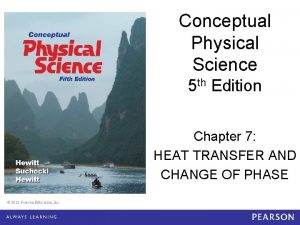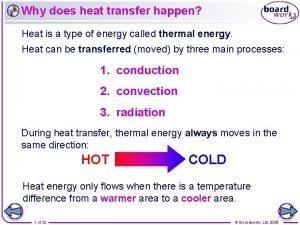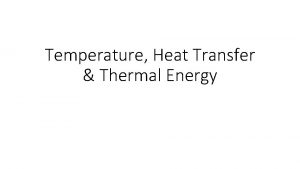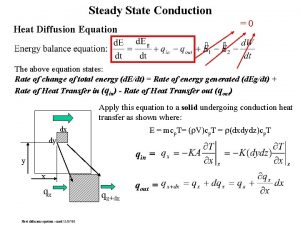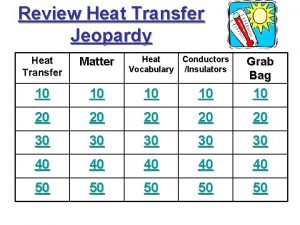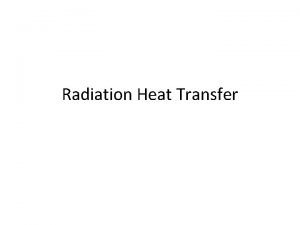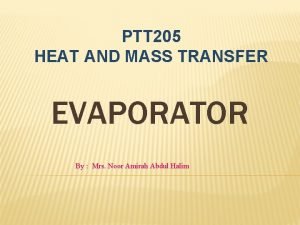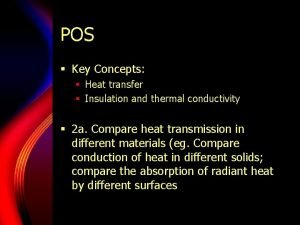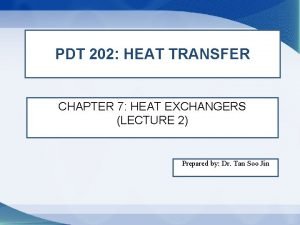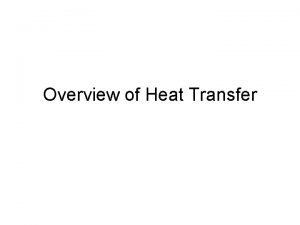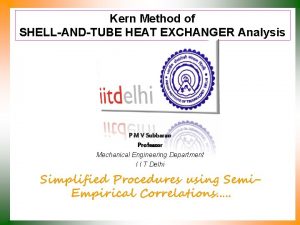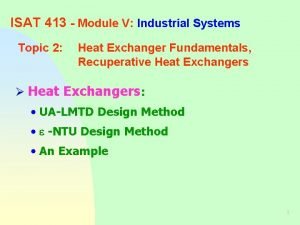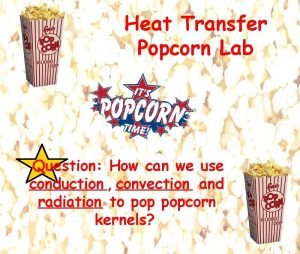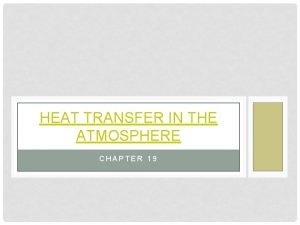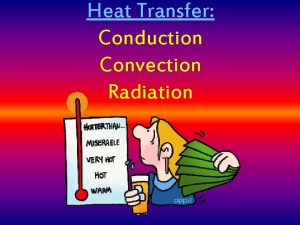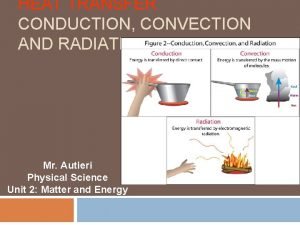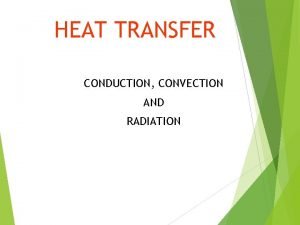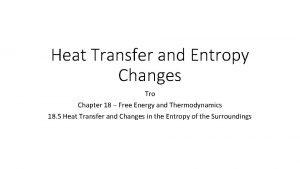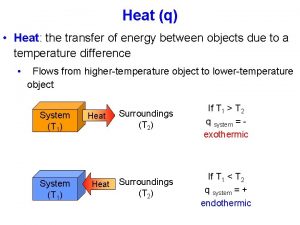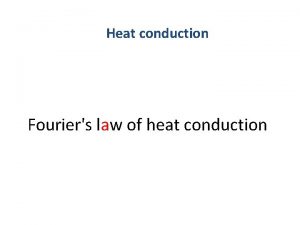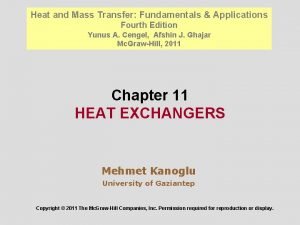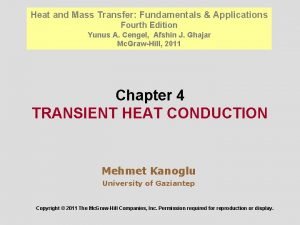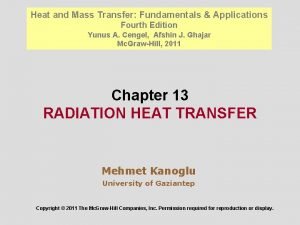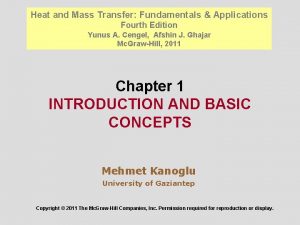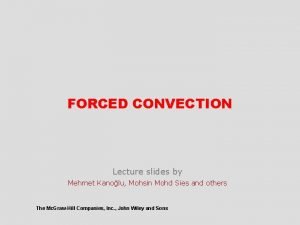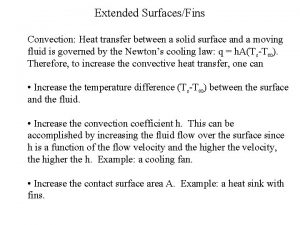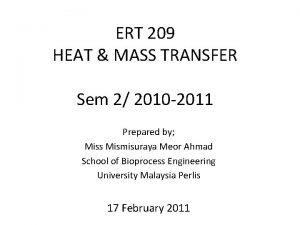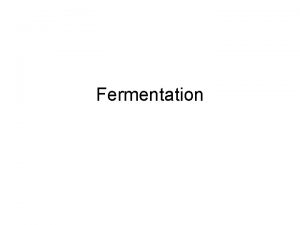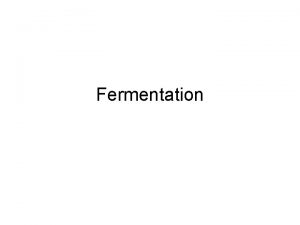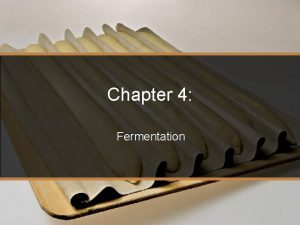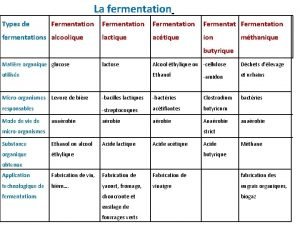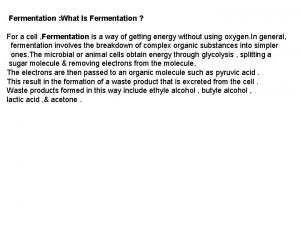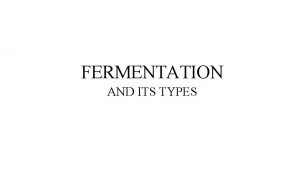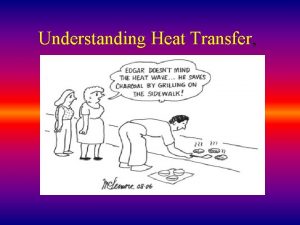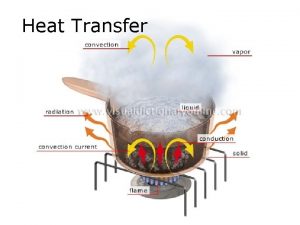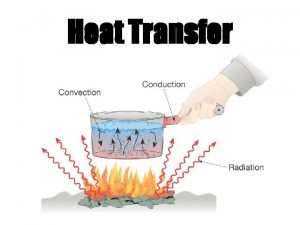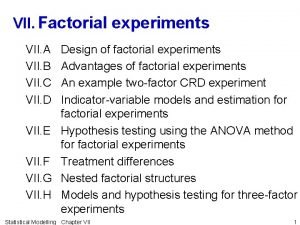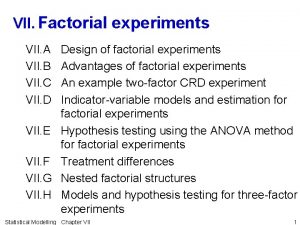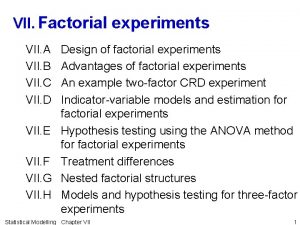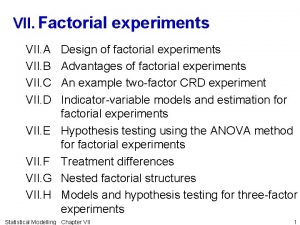Chapter VII Heat Transfer in Fermentation 1 1262020




































- Slides: 36

Chapter VII Heat Transfer in Fermentation 1 12/6/2020

Introduction Several important chemical engineering concepts in Bioprocess Engineering are transport phenomena (fluid flow, mixing, heat and mass transfer), unit operations, reaction engineering, and bioreactor engineering. Fluid flow, mixing, and reactor engineering are skipped in this class. They are available more detail in several chemical engineering books. We start with the heat transfer in bioreactors 2

Two types of common heat transfer application in bioreactor operation • In situ batch sterilization of liquid medium. In this process, the fermenter vessel containing medium is heated using steam and held at the sterilization temperature for a period of time; cooling water is then used to bring the temperature back to normal operating conditions • Temperature control during reactor operation. Metabolic activity of cells generates heat. Some microorganisms need extreme temperature conditions (e. g. psycrophilic, thermophilic microorganisms) Heat transfer configurations for bioreactors: jacketed vessel, external coil, internal helical coil, internal baffle-type coil, and external heat exchanger. 3

Pro’s and cons of the heat exchanger configurations • External jacket and coil give low heat transfer area. Thus, they are rarely used for industrial scale. • Internal coils are frequently used in production vessel; the coils can be operated with liquid velocity and give relatively large heat transfer area. But the coil interfere with the mixing in the vessel and make cleaning of the reactor difficult. Another problem is film growth of cells on the heat transfer surface. • External heat exchanger unit is independent of the reactor, easy to scale up, and provide best heat transfer capability. However, conditions of sterility must be met, the cells must be able to withstand the shear forces imposed during pumping, and in aerobic fermentation, the residence time in the heat exchanger must be small enough to ensure the medium does not become depleted of oxygen. 4

Heat exchangers in fermentation processes • Double-pipe heat exchanger • Shell and tube heat exchanger • Plate heat exchanger • Spiral heat exchanger In bioprocess, the temperature difference is relatively small. Thus, plate heat exchanger is almost never being used The concepts and calculation for heat exchangers and their configurations are available in the text book ( Pauline Doran, Bioprocess Eng Principle, chapter 8) 5

Chapter VIII Mass Transfer in Fermentation 6 12/6/2020

Introduction The Fick’s law of diffusion Role of diffusion in Bioprocess • Scale of mixing Mixing on a molecular scale relies on diffusion as the final step in mixing process because of the smallest eddy size • Solid-phase reaction The only mechanism for intra particle mass transfer is molecular diffusion • Mass transfer across a phase boundary Oxygen transfer to gas bubble to fermentation broth, penicillin recovery from aqueous to organic liquid, glucose transfer liquid medium into mould pellets are typical example. 7

Film theory The two film theory is a useful model for mass transfer between phase. Mass transfer of solute from one phase to another involves transport from bulk of one phase to the interface, and then from the interface to the bulk of the second phase. This theory is based on idea that a fluid film or mass transfer boundary layer forms whenever there is contact between two phases. According to film theory, mass transfer through the film is solely by molecular diffusion and is the major resistance. CA 1 i Bulk fluid 2 CA 1 Bulk fluid 1 CA 2 i Film 2 Film 1 8

Convective mass transfer It refers to mass transfer occurring in the presence of bulk fluid motion k: mass transfer coefficient [m/s] a: area available for mass transfer [m 2/m 3] CAo: concentration of A at bulk fluid CAi: concentration of A at interface For gas-liquid system, A from gas to liquid: 9

Overall mass transfer coefficient Refers to the book Geankoplis (2003), Transport Processes and Separation Process Principles, 4 th ed, chapter 10. 4. Oxygen transport to fermentation broth can be modeled as diffusion of A through stagnant or non-diffusing B. If A is poorly soluble in the liquid, e. g. oxygen in aqueous solution, the liquid-phase mass transfer resistance dominates and k. Ga is much larger than k. La. Hence, KLa ≈ k. La. 10

Oxygen transfer from gas bubble to cell Eight steps involved: i. iii. Transfer from the interior of the bubble to the gas-liquid interface Movement across the gas-liquid interface Diffusion through the relatively stagnant liquid film surrounding the bubble iv. Transport through the bulk liquid v. Diffusion through the relatively stagnant liquid film surrounding the cells vi. Movement across the liquid-cell interface vii. If the cells are in floc, clump or solid particle, diffusion through the solid of the individual cell viii. Transport through the cytoplasm to the site of reaction. 11

Analyzes for most bioreactors in each step involved i. iii. Transfer through the bulk phase in the bubble is relatively fast The gas-liquid interface itself contributes negligible resistance The liquid film around the bubble is a major resistance to oxygen transfer iv. In a well mixed fermenter, concentration gradients in the bulk liquid are minimized and mass transfer resistance in this region is small, except for viscous liquid. v. The size of single cell <<< gas bubble, thus the liquid film around cell is thinner than that around the bubble. The mass transfer resistance is negligible, except the cells form large clumps. vi. Resistance at the cell-liquid interface is generally neglected vii. The mass transfer resistance is small, except the cells form large clumps or flocs. viii. Intracellular oxygen transfer resistance is negligible because of the small distance involved 12

Chapter IX Unit Operations in Fermentation (introduction to downstream processing) 13 12/6/2020

Downstream processing, what and why Downstream processing is any treatment of culture broth after fermentation to concentrate and purify products. It follows a general sequence of steps: 1. Cell removal (filtration, centrifugation) 2. Primary isolation to remove components with properties significantly different from those of the products (adsorption, liquid extraction, precipitation). Large volume, relatively non selective 3. Purification. Highly selective (chromatography, ultra filtration, fractional precipitation) 4. Final isolation (crystallization, followed by centrifugation or filtration and drying). Typical for high-quality products such as pharmaceuticals. 5. Downstream processing mostly contributes 40 -90 % of total cost. 14

Filtration Type of filtration unit: • Plate and frame filter. For small fermentation batches • Rotary-drum vacuum filter. Continuous filtration that is widely used in the fermentation industry. A horizontal drum 0. 5 -3 m in diameter is covered with filter cloth and rotated slowly at 0. 1 -2 rpm. The filtration theory and equation are not explained here since they are available in the course “Unit Operations of Chemical Engineering I”. 15

Centrifugation is used to separate materials of different density when a force greater than gravity is desired The type of industrial centrifugation unit: • Tubular bowl centrifuge (Narrow tubular bowl centrifuge or ultracentrifuge, decanter centrifuge, etc). Simple and widely applied in food and pharmaceutical industry. Operates at 13000 -16000 G, 105 -106 G for ultracentrifuge • Disc-stack bowl centrifuge. This type is common in bioprocess. The developed forces is 5000 -15000 G with minimal density difference between solid and liquid is 0. 01 -0. 03 kg/m 3. The minimum particle diameter is 5 µm 16

Centrifugation (dry solid decanter centrifuge) 17

The centrifugation theory The terminal velocity during gravity settling of a small spherical particle in dilute suspension is given by Stoke’s law: Where ug is sedimentation velocity under gravity, ρp is particle density, ρf is liquid density, µ is liquid viscosity, Dp is diameter of the particle, and g is gravitational acceleration. In the centrifuge: uc is particle velocity in the centrifuge, ω is angular velocity in rad/s, and r is radius of the centrifuge drum. 18

The centrifugation theory The ratio of velocity in the centrifuge to velocity under gravity is called the centrifuge effect or G-number. Industrial Z factors: 300 -16 000, small laboratory centrifuge may up to 500 000. The parameter for centrifuge performance is called Sigma factor Q is volumetric feed rate. The Sigma factor explain cross sectional area of a gravity settler with the same sedimentation characteristics as the centrifuge. If two centrifuge perform with equal effectiveness 19

The centrifugation theory Disc-stack bowl centrifuge N is number of disc, θ is half-cone angle of the disc. The r 1 and r 2 are inner and outer radius of the disc, respectively. Tubular-bowl centrifuge b is length of the bowl, r 1 and r 2 are inner and outer radius of the wall of the bowl. 20

Cell disruption Mechanical cell disruption methods • French press (pressure cell) and high-pressure homogenizers. In these devices, the cell suspension is drawn through a check valve into a pump cylinder. At this point, it is forced under pressure (up to 1500 bar) through a very narrow annulus or discharge valve, over which the pressure drops to atmospheric. Cell disruption is primary achieved by high liquid shear in the orifice and the sudden pressure drop upon discharge causes explosion of the cells. • Ultrasonic disruption. It is performed by ultrasonic vibrators that produce a high-frequency sound with a wave density of approximately 20 k. Hz/s. A transducer convert the waves into mechanical oscillations via a titanium probe immersed in the concentrated cell suspension. For small scale 21

Cell disruption 22

The equation for Manton-Gaulin homogenizer Rm: maximum amount protein available for release R: amount of protein release after N passes through the homogenizer k: temperature-dependent rate constant p: operating pressure drop : resistance parameter of the cells, for S. cerevisiae is 2. 9 23

Cell disruption Non mechanical cell disruption methods Autolysis, use microbe own enzyme for cell disruption Osmotic shock. Equilibrating the cells in 20% w/v buffered sucrose, then rapidly harvesting and resuspending in water at 4 o. C. Addition of chemicals (EDTA, Triton X-100), enzymes (hydrolyses, bglucanases), antibiotics (penicillin, cycloserine) 24

Chromatography Chromatographic techniques usually employed for high value products. These methods, normally involving columns of chromatographic media (stationary phase), are used for desalting, concentration and purification of protein preparations. Several important aspects are molecular weight, isoelectric point, hydrophobicity and biological affinity. The methods are: 1. Adsorption chromatography 2. Affinity chromatography 3. Gel filtration chromatography 4. High performance liquid chromatography 5. Hydrophobic chromatography 6. Metal chelate chromatography 25

Finishing steps (final isolation) Crystallization Product crystallization may be achieved by evaporation, low-temperature treatment or the addition of a chemical reactive with the solute. The product’s solubility can be reduced by adding solvents, salts, polymers, and polyelectrolytes, or by altering p. H. Drying involves the transfer of heat to the wet material and removal of the moisture as water vapor. Usually, this must be performed in such a way as to retain the biological activity of the product. The equipment could be rotary drum drier, vacuum tray drier, or freeze-drier. 26

Chapter X Bioreactor 27 12/6/2020

Bioreactor configurations Stirred tank bioreactor Similar to CSTR; this requires a relatively high input of energy per unit volume. Baffles are used to reduce vortexing. A wide variety of impeller sizes and shapes is available to produce different flow patterns inside the vessel; in tall fermenters, installation of multiple impellers improves mixing. Typically, only 70 -80 % of the volume of stirred reactors is filled with liquid; this allows adequate headspace for disengagement of droplets from exhaust gas and to accommodate any foam which may develop. Foam breaker may be necessary if foaming is a problem. It is preferred than chemical antifoam because the chemicals reduce the rate of oxygen transfer. The aspect ratio (H/D) of stirred vessels vary over a wide range. When aeration is required, the aspect ratio is usually increased. This provides for longer contact times between the rising bubbles and liquid and produces a greater hydrostatic pressure at the bottom of the vessel. Care is required with particular catalysts or cells which may be damaged or destroyed by the impeller at high speeds. 28

Bioreactor configurations 29

Bioreactor configurations Bubble column In bubble-column reactors, aeration and mixing are achieved by gas sparging; this requires less energy than mechanical stirring. Bubble columns are applied industrially for production of bakers’ yeast, beer and vinegar, and for treatment of wastewater. A height-to-diameter ration of 3: 1 is common in bakers’ yeast production; for other applications, towers with H/D of 6: 1 have been used. The advantages are low capital cost, lack of moving parts, and satisfactory heat and mass transfer performance. Foaming can be problem. Homogeneous flow: all bubbles rise with the same upward velocity and there is no back-mixing of the gas phase. Heterogeneous flow: At higher gas velocity. Bubbles and liquid tend to rise up in the center of the column while a corresponding down flow of liquid occurs near the walls. 30

Bioreactor configurations Airlift reactors are often chosen for culture of plant and animal cells and immobilized catalyst because shear level are low. Gas is sparged into only part of the vessel cross section called the riser. Gas hold-up and decreased liquid fluid density cause liquid in the riser to move upwards. Gas disengages at the top of the vessel leaving heavier bubble-free liquid to recirculate through the downcomer. Airlift reactors configurations are internal-loop vessels and external-loop vessels. In the internal-loop vessels, the riser and downcomer are separated by an internal baffle or draft tube. Air may be sparged into either the draft tube or the annulus. In the external-loop vessels, separated vertical tubes are connected by short horizontal section at the top and bottom. Because the riser and downcomer are further apart in externalloop vessels, gas disengagement is more effective than in internal-loop devices. Fewer bubbles are carried into the downcomer, the density difference between fluids in the riser and downcomer is greater, and circulation of liquid in the vessel is faster. Accordingly, mixing is usually better in external-loop than internal-loop reactors. 31

Bioreactor configurations 32

Stirred and air-driven reactors: comparison of operating characteristic For low-viscosity fluids, adequate mixing and mass transfer can be achieved in stirred tanks, bubble columns and airlift vessels. When a large fermenter (50500 m 3) is required for low-viscosity culture, a bubble column is an attractive choice because it is simple and cheap to install and operate. Mechanicalagitated reactors are impractical at volumes greater than about 500 m 3 as the power required to achieve adequate mixing becomes extremely high. Stirred reactor is chosen for high-viscosity culture. Nevertheless, mass transfer rates decline sharply in stirred vessels at viscosities > 50 -100 c. P. Mechanical-agitation generates much more heat than sparging of compressed gas. When the heat of reaction is high, such as in production of single cells protein from methanol, removal of frictional stirrer heat can be problem so that air-driven reactors may be preferred. Stirred-tank and air-driven vessels account for the vast majority of bioreactor configurations used for aerobic culture. However, other reactor configurations may be used in particular processes 33

Other bioreactors Packed bed Used with immobilized or particulate biocatalysts, for example during the production of aspartate and fumarate, conversion of penicillin to 6 aminopenicillanic acid, and resolution of amino acid isomers. Damaged due to particle attrition is minimal in packed beds compared with stirred reactors. Mass transfer between the liquid medium and solid catalyst is facilitated at high liquid flow rate through the bed. To achieve this, packed are often operated with liquid recycle. The catalyst is prevented from leaving the columns by screens at the liquid exit. Aeration is generally accomplished in a separated vessel because if air is sparged directly into the bed, bubble coalescence produces gas pockets and flow channeling or misdistribution. Packed beds are unsuitable for processes which produce large quantities of carbon dioxide or other gases which can become trapped in the packing. 34

Other bioreactors Fluidized bed To overcome the disadvantages of packed bed, fluidized bed may be preferred. Because particles are in constant motion, channeling and clogging of the bed are avoided and air can be introduced directly into the column. Fluidized bed reactors are used in waste water treatment with sand or similar material supporting mixed microbial populations, and with flocculating organisms in brewing and production of vinegar. Trickle bed Is another variation of the packed bed. Liquid is sprayed onto top of the packing and trickles down through the bed in small rivulets. Air may be introduced at the base; because the liquid phase is not continuous throughout the column, air and other gases move with relative ease around the packing. Trickle-bed reactors are used widely for aerobic wastewater treatment. 35

Other bioreactors 36
 1262020 starter
1262020 starter Chapter 22 heat transfer exercises answers
Chapter 22 heat transfer exercises answers Why does a good absorber of radiant energy appear black?
Why does a good absorber of radiant energy appear black? Chapter 7 heat transfer and change of phase
Chapter 7 heat transfer and change of phase A wave is a disturbance that transfers energy
A wave is a disturbance that transfers energy Heat transfer in metal
Heat transfer in metal Viscosity unit
Viscosity unit How is thermal energy transferred?
How is thermal energy transferred? Heat and temperature
Heat and temperature Heat energy equation
Heat energy equation Jeopardy
Jeopardy Example of heat transfer by radiation
Example of heat transfer by radiation Open kettle evaporator
Open kettle evaporator Energy transfer
Energy transfer Ntu method
Ntu method Heat transfer overview
Heat transfer overview Triangular pitch formula
Triangular pitch formula Ntu heat transfer
Ntu heat transfer Conduction popcorn
Conduction popcorn Radiation examples
Radiation examples Heat transfer on earth
Heat transfer on earth How does heat move
How does heat move Example of radiation heat transfer
Example of radiation heat transfer What is heat transfer conduction convection and radiation
What is heat transfer conduction convection and radiation 3 ways of heat transfer
3 ways of heat transfer Radiation heat transfer examples
Radiation heat transfer examples Entropy and heat transfer
Entropy and heat transfer Heat transfer videos
Heat transfer videos G/4
G/4 Radial heat conduction
Radial heat conduction The overall heat transfer coefficient
The overall heat transfer coefficient Heat and mass transfer
Heat and mass transfer Heat transfer radiation
Heat transfer radiation Heat and mass transfer fundamentals and applications
Heat and mass transfer fundamentals and applications Petukhov equation
Petukhov equation Heat transfer from extended surfaces fins
Heat transfer from extended surfaces fins Bulk temperature formula
Bulk temperature formula



